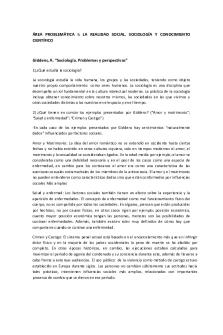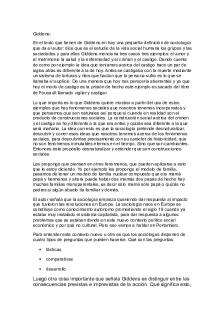Giddens Concept 10 PDF

| Title | Giddens Concept 10 |
|---|---|
| Author | Ashley Grace |
| Course | Fam Crisis Cmpl Hlth Prob II |
| Institution | Florida State College at Jacksonville |
| Pages | 3 |
| File Size | 115.7 KB |
| File Type | |
| Total Downloads | 26 |
| Total Views | 139 |
Summary
Giddens Concept 10 Test Pool...
Description
Concepts for Nursing Practice 2nd Edition Giddens Test Bank
Concept 10: Thermoregulation Giddens: Concepts for Nursing Practice, 2nd Edition MULTIPLE CHOICE 1. The nursery nurse should identify which newborn at significant risk for hypothermic
alteration in thermoregulation? a. Large for gestational age b. Low birth weight c. Born at term d. Well nourished ANS: B
Low birth weight and poorly nourished infants (particularly premature infants) and children are at greatest risk for hypothermia. A large for gestational age infant would not be malnourished. An infant born at term is not considered at significant risk. A well nourished infant is not at significant risk. REF: Page 88 OBJ: NCLEX® Client Needs Category: Physiological Integrity: Physiological Adaptation 2. A volunteer at the senior center asks the visiting nurse why the senior citizens always seem to
be complaining about the temperature. What is the nurse’s best response? a. Older people have a diminished ability to regulate body temperature because of active sweat glands. b. Older people have a diminished ability to regulate body temperature because of increased circulation. c. Older people have a diminished ability to regulate body temperature because of peripheral vasoconstriction. d. Older people have a diminished ability to regulate body temperature because of slower metabolic rates. ANS: D
Slower metabolic rates are one factor that reduces the ability of older adults to regulate temperature and be comfortable when there are any temperature changes. As the body ages, the sweat glands decrease in number and efficiency. Older adults have reduced circulation. The body conserves heat through peripheral vasoconstriction, and older adults have a decreased vasoconstrictive response, which impacts ability to respond to temperature changes. REF: Page 88 OBJ: NCLEX® Client Needs Category: Physiological Integrity: Physiological Adaptation 3. The nurse admitting a patient to the emergency department on a very hot summer day would
suspect hyperthermia when the patient demonstrates which assessment finding? a. Decreased respirations b. Low pulse rate c. Red, sweaty skin d. Slow capillary refill ANS: C
Concepts for Nursing Practice 2nd Edition Giddens Test Bank With hyperthermia, vasodilatation occurs causing the skin to appear flushed and warm or hot to touch. There is an increased respiration rate with hyperthermia. The heart rate increases with hyperthermia. With hypothermia there is slow capillary refill. REF: Page 89 OBJ: NCLEX® Client Needs Category: Physiological Integrity: Physiological Adaptation 4. What is the priority nursing action for a patient suspected to be hypothermic? a. Assess vital signs. b. Hydrate with intravenous (IV) fluids. c. Provide a warm blanket. d. Remove wet clothes. ANS: D
The first thing to do with a patient suspected to be hypothermic is to remove wet clothes, because heat loss is five times greater when clothing is wet. Assessing vital signs is important, but the wet clothes should be removed first. Hydration is very important with hyperthermia and the associated danger of dehydration, but there is not a similar risk with hypothermia. A warm blanket over wet clothes would not be an effective warming strategy. REF: Page 90 OBJ: NCLEX® Client Needs Category: Physiological Integrity: Physiological Adaptation 5. Which strategies should the nurse include in a community program for senior citizens related
to dealing with cold winter temperatures? a. Avoiding hot beverages b. Shopping at an indoor mall c. Using a fan at low speed d. Walking slowly in the park ANS: B
Shopping indoors where there is protection from the elements and temperature control is one strategy to avoid cold temperatures. Hot beverages can help an individual deal with cold weather. Avoiding breezes and air currents is recommended to conserve body temperature. Physical activity can increase body temperature, and if the senior is going to walk in the park, weather-appropriate (warm) clothing and a usual or brisk pace, not a slow pace, would be recommended. REF: Page 90 OBJ: NCLEX® Client Needs Category: Physiological Integrity: Physiological Adaptation 6. During orientation to an emergency department, the nurse educator would be concerned if the
new nurse listed which of the following as a risk factor for impaired thermoregulation? a. Impaired cognition b. Occupational exposure c. Physical agility d. Temperature extremes ANS: C
Concepts for Nursing Practice 2nd Edition Giddens Test Bank Physical agility is not a risk factor for impaired thermoregulation. The nurse educator would use this information to plan additional teaching to include medical conditions and gait disturbance as risk factors for hypothermia, because their bodies have a reduced ability to generate heat. Impaired cognition is a risk factor. Recreational or occupational exposure is a risk factor. Temperature extremes are risk factors for impaired thermoregulation. REF: Page 88 |Page 89 OBJ: NCLEX® Client Needs Category: Physiological Integrity: Physiological Adaptation 7. What is the most appropriate measure for a nurse to use in assessing core body temperature
when there are suspected problems with thermoregulation? Oral thermometer Rectal thermometer Temporal thermometer scan Tympanic membrane sensor
a. b. c. d.
ANS: B
The most reliable means available for assessing core temperature is a rectal temperature, which is considered the standard of practice. An oral temperature is a common measure but not the most reliable. A temporal thermometer scan has some limitations and is not the standard. The tympanic membrane sensor could be used as a second source for temperature assessment. REF: Page 89 OBJ: NCLEX® Client Needs Category: Physiological Integrity: Physiological Adaptation 8. The nurse planning care for a patient with hypothermia should consider what similar
exemplar? a. Heat exhaustion b. Heat stroke c. Infection d. Prematurity ANS: D
Prematurity, frost bite, environmental exposure, and brain injury are considered exemplars of hypothermia. Heat exhaustion is an exemplar of hyperthermia. Heat stroke is an exemplar of hyperthermia. Infection is an exemplar of hyperthermia. REF: Page 89 OBJ: NCLEX® Client Needs Category: Physiological Integrity: Physiological Adaptation...
Similar Free PDFs

Giddens Concept 10
- 3 Pages

Giddens
- 4 Pages

Giddens resumen
- 3 Pages

Giddens unidad 1
- 3 Pages

Sociologia giddens
- 4 Pages

Giddens Anthony Socjologia
- 91 Pages

Anthon Giddens Socjologia 1
- 23 Pages

Anthony Giddens Sociologia
- 743 Pages

Giddens og individualisering
- 2 Pages

Mills i Giddens lectura
- 10 Pages

FIL Concept Paper - Lecture notes 10
- 29 Pages

La terza via articolo - Giddens
- 2 Pages
Popular Institutions
- Tinajero National High School - Annex
- Politeknik Caltex Riau
- Yokohama City University
- SGT University
- University of Al-Qadisiyah
- Divine Word College of Vigan
- Techniek College Rotterdam
- Universidade de Santiago
- Universiti Teknologi MARA Cawangan Johor Kampus Pasir Gudang
- Poltekkes Kemenkes Yogyakarta
- Baguio City National High School
- Colegio san marcos
- preparatoria uno
- Centro de Bachillerato Tecnológico Industrial y de Servicios No. 107
- Dalian Maritime University
- Quang Trung Secondary School
- Colegio Tecnológico en Informática
- Corporación Regional de Educación Superior
- Grupo CEDVA
- Dar Al Uloom University
- Centro de Estudios Preuniversitarios de la Universidad Nacional de Ingeniería
- 上智大学
- Aakash International School, Nuna Majara
- San Felipe Neri Catholic School
- Kang Chiao International School - New Taipei City
- Misamis Occidental National High School
- Institución Educativa Escuela Normal Juan Ladrilleros
- Kolehiyo ng Pantukan
- Batanes State College
- Instituto Continental
- Sekolah Menengah Kejuruan Kesehatan Kaltara (Tarakan)
- Colegio de La Inmaculada Concepcion - Cebu



